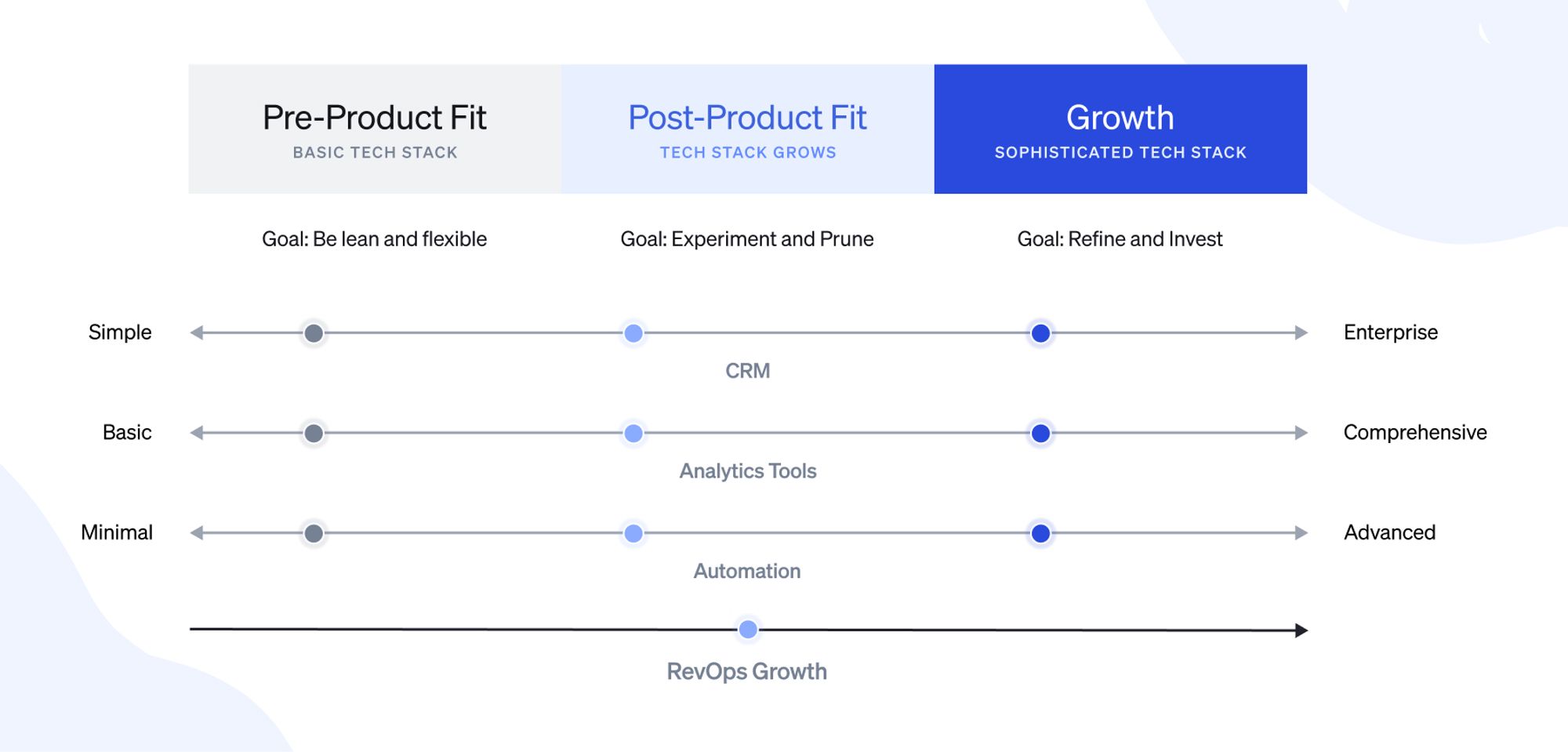Why every great RevOps team starts with a diagram

Here's the uncomfortable truth: Your RevTech stack probably isn't broken because of the tools you picked. It's broken because you're thinking about RevTech all wrong.
I’ve worked with companies across the board — from early-stage startups to scale-ups like Ramp. And in every engagement, I start with one question: "Can you show me how your system works?"
The answer is usually a sigh, followed by: "We have a Lucidchart from a few years ago, but it’s out of date."
If that sounds familiar, you're not alone. But it also means you're flying blind.
Diagramming your stack isn’t just a documentation task. It’s a test of your systems thinking. If you can’t map how your tools work together — how they actually support revenue, not just sit in your tech stack — then you’re not really running RevTech. You’re managing software.
This gap? It’s what separates tactical operators from strategic ones. The teams that consistently ship, scale, and adapt are the ones who map their systems early and often. Not because it’s a formality, but because it creates clarity — the kind that informs better decisions across product, go-to-market (GTM), and ops.
Most people get revtech backwards
Ask 10 founders what RevTech is, and most of them will start listing tools. Salesforce. Outreach. HubSpot. Clearbit. Maybe some AI-powered plugin that auto-fills notes.
But tools are just the surface layer.
RevTech is the system underneath. It’s the way your people, processes, and platforms combine to drive revenue outcomes. Tools are only one-third of the equation. The other two thirds? People and process. And those are what actually make or break everything.
When your tech stack is working against your reps instead of for them, the problem isn't adoption. It's architecture. The best operators build systems that maximize capabilities with minimal resources. This is how you get what I call a RevOps powerhouse.
Here’s what separates strategic teams from tactical ones
They can draw their system.
Want to spot a high-functioning RevOps team? Ask to see their system diagram. Not a Notion doc. Not a spreadsheet of tools. An actual diagram showing what tools are in the stack, how data moves between them, and what purpose each connection serves.
Diagramming seems simple, but it's wildly underrated for five reasons:
First, it forces understanding. You can't draw what you don't comprehend. Mapping your stack exposes gaps in your thinking and areas where flow breaks down.
Second, it drives alignment. New hires, execs, vendors — everyone gets a shared visual instead of five different explanations of the same system.
Third, it reveals redundancies. Suddenly you realize you're paying for three enrichment tools or that your lead routing logic overlaps with your outbound platform.
Fourth, it shows you where to focus. Every system has broken parts, but not all are worth fixing right now.
Fifth — and this one is subtle — it builds credibility. When your CRO asks how your RevTech stack works and you pull up a clean, layered diagram showing current state plus proposed improvements, you go from "tool person" to "strategic partner."
Why the old way stopped working
Back in 2016, I made a lot of hub-and-spoke diagrams. Everything flowed into a customer data platform (CDP) like mParticle, and from there into every other tool. It looked clean. Centralized. Elegant.
In practice? It created a brittle system.
One bad input corrupted the entire flow. Getting data back into the hub was nearly impossible. Debugging took forever. Every tool became reliant on the hub's structure and limitations.
We saw it firsthand at Postmates. If mParticle went down or received incomplete data, everything downstream — email campaigns, personalization, performance tracking — fell apart. The stack wasn’t resilient. It was just tidy.
This model also creates false confidence. When the diagram looks good, people assume the system is working as intended. But in reality, it hides how fragile things really are.
Today, this model just doesn’t scale. Most companies need more flexibility. More flow. Less centralization for the sake of aesthetics.
The gravity principle changes everything
Think of your stack like a funnel with gravity:
- Top = data generation (CDP, website, ads)
- Middle = sales execution (CRM, outreach tools, call logging)
- Bottom = analysis and reporting (warehouse, dashboards, commissions)
Your goal? Move data from top to bottom. Fast to slow. Light to heavy. Why? Because it's easier to manage, debug, and reason about.
This doesn’t mean you never push data back upstream. Sometimes you do. For example, enriching CRM records from warehouse models. Or syncing closed-won customers into your ad platforms to suppress spend. But these upstream flows should be rare, intentional, and diagrammed.
I worked with one company that had five bidirectional syncs between Salesforce, HubSpot, Segment, and two enrichment tools. Nobody knew where truth lived. Changing one field triggered cascading updates that created more confusion than clarity.
This is what happens when you violate gravity.
Our stack: Imperfect on purpose
We get this question a lot: "You’re a CRM company. So what does your own stack look like?"
It looks like this:
- CDP: PostHog
- CRM: Clarify
- Enrichment: Apollo, Clearbit (some flows native, some via Zapier)
- Outbound: Lemlist, Unify
- Reporting: Hex
- Warehouse: AWS
- Glue: Zapier and a few custom connectors
It’s not elegant. Some pieces are stitched together. Others are manual.
We manually pull LinkedIn ad data through a database connector. Some of our enrichment happens in Zapier. Some happens natively inside Clarify. There are little workarounds everywhere.
But it works. Because we understand it. Because it's diagrammed. And because we've accepted where it makes sense to be imperfect.
We revisit our diagram monthly, tagging things as "working," "temporary," or "needs upgrade." When something breaks, we know where to look. And we don't treat "temporary" as dirty — we treat it as buying time, on purpose.
The “perfect” stack is a myth
Here's what I tell every founder who asks about the "best" RevTech setup: There isn't one.
Your stack isn't supposed to look like Ramp's or HubSpot's or whoever raised $100M last quarter. It's supposed to work for your stage, your team, and your constraints. That's it.
I've mapped stacks for companies across every stage — pre-PMF startups running on Zapier and prayer, post-PMF teams drowning in tool complexity, growth companies finally getting the CDP-CRM dance right. The patterns are clear:
Pre-PMF teams win with simplicity. Early stage companies (like us here at Clarify)keep connections minimal, tools modular, processes manual. When you're still figuring out who your customer is, quickly jumping on leads beats sophisticated nurture sequences. Every unnecessary integration slows you down.
Post-PMF teams experiment heavily. They add attribution tools, upgrade CRMs, test CDPs. The risk? Overbuilding before you can manage it. One company I worked with had enterprise tooling at seed stage — great features, zero bandwidth to use them properly.
Growth teams blend martech and RevTech. They get the CDP-CRM handoff right. Marketing segments flow into sales workflows. Product usage triggers outbound sequences. It's complex, but purposefully so.

Want to see this in action? We mapped eleven real stacks — from scrappy pre-PMF setups to growth-stage powerhouses — and broke down exactly what works (and what doesn't) at each stage.
The warehouse-first future is here
The warehouse has become the nervous system of modern RevTech. At Clarify, we stream everything — CDP data, CRM activities, outbound events — into AWS. Then we analyze in Hex and send insights back to systems that need them.
Enriched contact records flow from warehouse to Clarify. Suppression lists from modeled customers update Lemlist and Unify. PostHog events flow in for deeper analysis beyond surface-level tracking.
This gives us flexibility without vendor lock-in. We can model and remap as needed. Most importantly, we can trace every transformation back to its source. As we grow, we don't reinvent architecture — we just swap in better tooling or expand models without breaking core flows.
The truth nobody wants to admit
Every RevTech system is broken. Some teams are just more honest about it.
You can't eliminate all issues. You can only choose which problems you want to have. Which tradeoffs you're willing to make. The goal isn't flawlessness — it's progress.
I've never seen an organization where everything was "fixed." Not startups, not Capital One. There are only versions of "bad" that get progressively easier to manage.
Start here: Map before you buy
If you're rethinking your stack, don't start by pricing new vendors. Start by diagramming what you already have.
Map the tools. Map the flows. Label the known issues. Then ask:
- Where does flow break down?
- Which flows are working?
- What can you consolidate?
- What can you live with?
From there, build. And treat that diagram like an evolving document, not a one-time exercise.
Your diagram is your strategic advantage
The companies that win in RevTech aren't the ones with the biggest budgets or most integrations. They're the ones who think in systems. Who treat their stack like a living product.
They know what flows where. They know what's duct-taped. They know what's next.
Your diagram is the first draft of your stack. Don't skip it.
Make it real. Keep it updated. Use it to drive better conversations — with your execs, your team, and yourself.
This is how RevTech becomes a strategic advantage instead of an expensive headache.
Get our newsletter
Subscribe for weekly essays on GTM, RevTech, and Clarify’s latest updates.
Thanks for subscribing! We'll send only our best stuff. Your information will not be shared and you can unsubscribe at any time.
